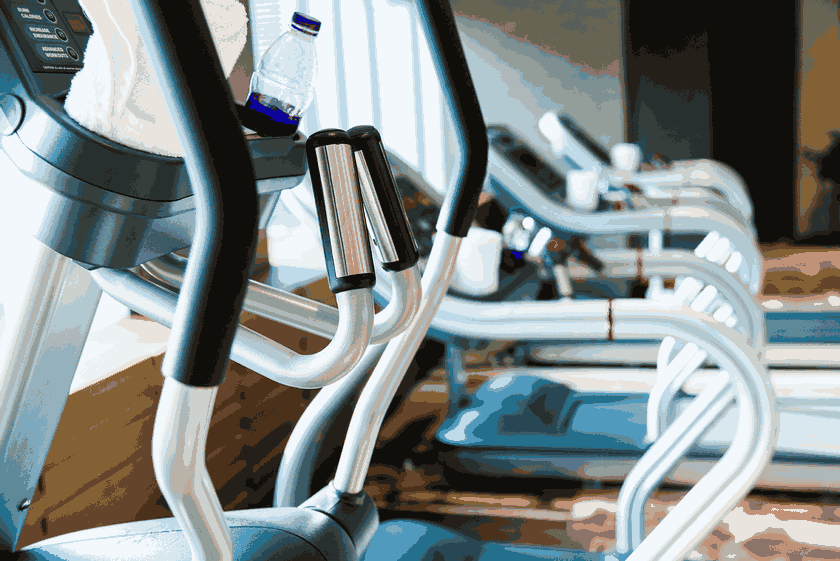Ever notice that cardio has a certain sound to it?
Walk into any big box gym and you’ll probably hear the huffs and puffs of heavy breathing, the whirring and purring of cardio machines — lots of cardio machines. We’re talking: treadmills, ellipticals, stair machines, rowers, and potentially others. Today, there are so many options for stationary aerobic training, you can waist a lot of time getting lost in the noise, wondering which machine you should choose for your workout.
So to help you make a decision, we are going to compare two of the most common machines around: the treadmill and the elliptical.
Both are decent tools to improve your aerobic fitness (hello, happy heart and happy lungs!) but each come with their own set of pros and cons. Here’s everything you need to know about the treadmill and the elliptical so that you can decide what’s best for you on any given day.
The Treadmill
This device features a moving conveyor belt that allows you to walk, jog, or run in place. On most treadmills, you can control the speed, the incline, track your distance, pace and even program interval training.
Getty Images
What the Treadmill Targets
Running, jogging, or walking on this machine will mainly target your lower body. Sprinting is really effective in tightening up your core as well. So if you hit a tough treadmill workout, look for the burn in your calves, glutes, hamstrings, quads, and abs.
When to Use The Treadmill
This machine is awesome for avid runners and racers who want to avoid training in adverse weather. Because treadmills are so advanced nowadays, you can accurately track mileage, monitor your pace, and set your goals.
If you aren’t into hour-long runs, you can easily create a shorter HIIT workout by choosing your intervals and rest times. High intensity interval training that lasts anywhere from 10 to 30 minutes can be really effective for anyone with endurance or weight loss goals.
Treadmills are a useful tool to control your pace and push your speed. Because the velocity of the conveyor belt is generated by the machine and not your own horsepower, bumping up that MPH will force you to try to keep up and to get used to running fast. This may be tougher to do if you’re outside trying to challenge yourself on your own.
While you’re on the treadmill, you can also focus on working on your running form without the high impact of running on concrete or similar surfaces. However, just know that perfecting your natural running form on treadmills is limited. Since that conveyor belt is doing some of the work to propel you forward, the muscles in your legs and feet don’t have to engage as much to get you going. If you can swing it, outdoor running is ideal for doing drills and mastering form since treadmill running can cause some people to shorten their gait.
Even if running isn’t your no. 1 hobby, this machine is still really effective in strengthening your lower body. This is especially true if you’re running on an incline. While running on a treadmill will not replace the overall strength and power gains of weighted squats or lunges, it’s still a great way to challenge your legs’ endurance.
When Not to Use The Treadmill
This is not the best machine to use if you are dealing with an ankle, knee, or hip injury. While running on a treadmill puts less stress on your joints than, say, running running on the sidewalk, it’s still better to take the load off and find a cardio option that is less weight-bearing. Biking, swimming, or the elliptical (which we will address below) are all great low-impact options.
To sum everything up:
Treadmill Pros:
- Strengthens your lower body and sometimes your core
- Great for race training when outdoor conditions are bad
- Can help to improve speed
- Can be used to program HIIT workouts
- Can be used to work on running form
- Can be used to train on an incline
- Good to use for weight loss
Treadmill Cons
- Not great for those healing from joint injuries (unless supervised by a physical therapist)
- Not the best for perfecting running gait
The Elliptical
This machine looks like it’s built for stationary cross country skiing in the sense that it has two foot holders to place your feet as well as two pole-like handles to grab on to. The locomotion on the elliptical is different, however. While your arms pump the handles back and forth, your feet cycle in the shape of an ellipses — that’s where the word “elliptical” comes from. You can go forward and backward on this machine. You can also increase the resistance to force your muscles to work harder. Only some ellipticals allow you to change the incline.
Getty Images
What the Elliptical Targets
The elliptical targets your hamstrings, quads, glutes, and many of the muscles of the lower body. If you push and pull the handles, this machine can work on your arm and upper back muscles. Because the elliptical engages the upper body, it can provide more of a full body workout than the treadmill. You can also use the machine hands free to work that core even more.
When to Use the Elliptical
The elliptical is an excellent low-impact cardio option for overtrained, achy joints. It’s not as much of a weight-bearing exercise as running is. So if you need a break from other high impact activities, this machine might be a great alternative.
Since you are able to move backwards on the elliptical, its great for isolating your hamstrings and your glutes. Running backwards is hard to do on a treadmill, particularly at a fast pace. So if you’re looking to tone up your buns during your cardio session, the elliptical might be your machine of choice. You can also perform HIIT workouts on the elliptical, making it a good tool for someone who has weight loss goals.
When Not to Use the Elliptical
The elliptical is not the best option for functional training. In other words, rarely in life or in (most) sports do you move the way you do on an elliptical. If your goal is to become a better at what many fitness experts call “functional” movements — like running, jumping, throwing, squatting, pivoting, lunging, etc. — solely training on this machine will not be very effective. But if you are training for the Elliptical Cycling World Championships, by all means, go for it.
If you are looking to log your mileage, the elliptical is not very useful — especially if you’re using different machines. Not all ellipticals are created equally. The amount of work that it will take to complete a mile on one device could be different on another.
And while it’s awesome that the elliptical doesn’t put as much stress on your joints, this does mean that it doesn’t have the capacity to strengthen your leg muscles as much as the treadmill. So if you are looking for more strength gains, running is your best bet.
To wrap it up:
Elliptical Pros:
- Great for low-impact exercise or active recovery
- Can target the upper and lower body
- Can be used to move backwards and isolate the hamstrings and glutes
- Great for HIIT workouts and interval training
- Good for weight loss goals
Elliptical Cons:
- It doesn’t train functional movement
- It doesn’t accurately track mileage
- It doesn’t strengthen as much as the treadmill
- May or may not be used to train on an incline
So, which is better: the treadmill or the elliptical?
Honestly, both the treadmill and the elliptical can be really effective tools. It depends on what you are training for, how your body feels on that particular training day, what training data you need, and what movement you most enjoy. Use those parameters as a rubric to help you decide which machine is best for you and go from there.
If you’re not very particular, use both and mix it up from time to time! While the amount of cardio tech out there may feel overwhelming, know at least that we’ve got all of these great options to keep us entertained.











